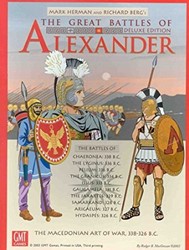 In 355 BC, the Phocians were in conflict with Thebes, and losing. They managed to turn this around by seizing the treasures held by the temples in Delphi and using them to pay for a very large mercenary army. This wasn’t well received by the Thebans, and the conflict became known as the “Sacred War” as the Thebans sought to punish the Phocians for their impiety. Meanwhile, Athens and Sparta were quite amused by all of this, and cheered the Phocians on from the sidelines. In 353 BC, Philip of Macedon got involved – calling himself “The Champion of Apollo” – and after a couple of battles with mixed results, he found himself in the field against a combined force of Athenians and Phocians, the Athenians joining in due to the presence of Philip.
In 355 BC, the Phocians were in conflict with Thebes, and losing. They managed to turn this around by seizing the treasures held by the temples in Delphi and using them to pay for a very large mercenary army. This wasn’t well received by the Thebans, and the conflict became known as the “Sacred War” as the Thebans sought to punish the Phocians for their impiety. Meanwhile, Athens and Sparta were quite amused by all of this, and cheered the Phocians on from the sidelines. In 353 BC, Philip of Macedon got involved – calling himself “The Champion of Apollo” – and after a couple of battles with mixed results, he found himself in the field against a combined force of Athenians and Phocians, the Athenians joining in due to the presence of Philip.
Or at least it was meant to be a combined force – Philip struck with such speed the Athenians were still on their boats when the battle started, and were never able to deploy.
The notes for this scenario indicate the Phocians have about 20,000 infantry and less than a thousand cavalry. Philip has about the same number of infantry but about 3,000 cavalry. In addition, Philip has the superior Macedonian phalanxes to the Phocian hoplites. The set-up to the battle looks like this:
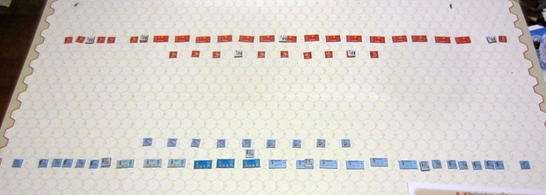
The Macedonian troops are in red at the top of the map, the Phocians and their allies are to the bottom of the map.
The most difficult thing about this battle would be controlling the troops. Yes, both sides would be using line commands (or Contingent Commanders in the case of the Macedonians), but there just weren’t enough leaders to handle everything. As a result, we had this odd situation where the rightmost troops of the Phocians got left behind. The early battle was all about the Macedonian cavalry, as it thundered into the left of the Phocian line. It’s astonishing that the line initially held, but it did – it was taking more hits than it was giving, but it wasn’t done yet!
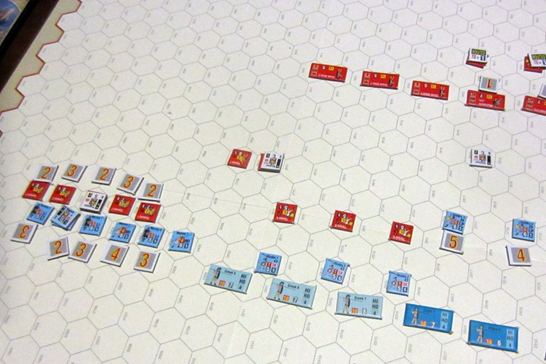
Otherwise, there was a lot of action going on between the various skirmish lines, with the semblance of “lines” quickly vanishing. Harrying and Dispersal attacks were the order of the day – at least for those who were in earshot of a commander!
On the far right, the very small cavalry forces on that side soon got involved, and finally the right-hand troops began to catch up with the rest of the battle. The phalanxes and hoplites began to march towards each other – the main battle was soon to begin! However, a great cry went up from the Phocian left flank, as the phalanxes there began to realise that the Macedonian cavalry had come away victorious and was now ready to charge their unprotected sides and rears!

This could have been so much more worse than it was; the light and medium Phocian infantry had managed to deal just enough damage to the Macedonian cavalry that they had to take out a few minutes to recuperate and regain their formations.
Before this could happen, the Phocian hoplites charged into the Macedonian phalanxes, hoping to catch them by surprise. They were partially successful, and the Macedonian commanders were soon kept busy urging on their men – and rallying the units that did try to flee. The crush was enough to send units from both sides fleeing, although the Macedonians had the commanders to successfully rally them.

Meanwhile, on the Phocian right flank, things were not going so well. Once again, the Macedonian leaders were able to rally their men better than the Phocians could rally there. Trumping and Momentum were the key here – Philip could trump attempts by the Phocian leaderships to gain momentum, and used his own momentum activations to rally as many units as he could. As a result, the Phocian hoplites would be unable to be rallied and thus be eliminated in the rout phase, while Philip could get back most of his troops.
The right flank of the Phocians collapsed and began to disintegrate. Mind you, as the Macedonians charged after their routing foes, they opened themselves up to potential reprisals…

They didn’t have the time, unfortunately. The Macedonians were just too dominant, and the Phocian commanders were unable to control enough of their men now that their lines had been splintered in the chaos of shock combat to properly take advantage of the holes in the Macedonian lines.
The main line of Phocian hoplites was now under assault from both flanks and from ahead, as the Macedonian cavalry finally thundered into them from the left and behind. Men ran, screaming to the gods for mercy – the rout was on.
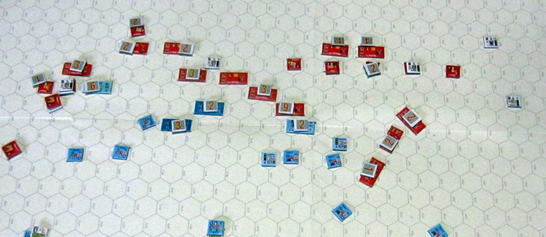
The Phocian army now in full retreat, the Macedonians pushed them back to the shore – and beyond. Historically, many died attempting to swim to the Athenian ships. About 6,000 died in the battle, including the Phocian commander, Onomarchus. In this game, it was a pretty comprehensive Macedonian victory. How many troops had the Macedonians lost in my playthrough? One phalanx counter and one light infantry counter. Not very much at all! (A couple of units were still in the process of routing, but they hadn’t made their way off the edge yet!)
Here’s the final picture of the whole battlefield:
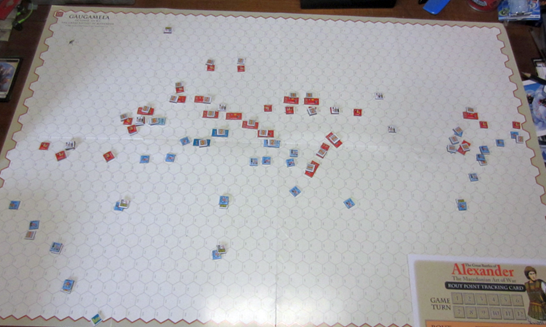
I really enjoy The Great Battles of Alexander. It’s nice to have the new edition – it’ll be even better when the new (error-free) counters arrive, though my set aren’t so bad!
